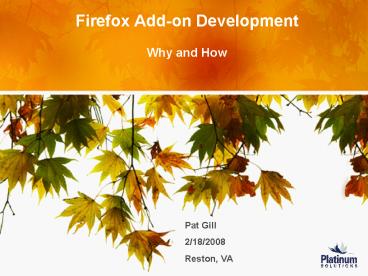Firefox Addon Development - PowerPoint PPT Presentation
1 / 19
Title:
Firefox Addon Development
Description:
Firefox add-ons only require basic knowledge of XML and JavaScript ... As far as add-ons go, ones on Firefox are good on any platform, are easier to ... – PowerPoint PPT presentation
Number of Views:279
Avg rating:3.0/5.0
Title: Firefox Addon Development
1
Firefox Add-on Development
- Why and How
Pat Gill 2/18/2008 Reston, VA
2
Objectives
- Learn what the advantages are of making a Firefox
Add-on vs. other browsers. - Understand that it doesnt take years of
programming experience to be able to make one. - Gain knowledge of the basic elements of an add-on
and basic development methods. - Find out about freely available resources so,
should you desire, you can start building your
own.
3
Overview
1
Introduction and my Experience
Why a Firefox Add-on?
Building the Add-on
Summary and Resources
4
Introduction
- Senior Design Project Page Sleuth
- Browser toolbar to analyze web page design
- Inherited add-on on top of Greasemonkey
- Bad interface
- Drew toolbar onto page
- Covered up page elements
- Certain cites disabled functionality
- Entire project code in one file
- Hard to read and understand
- Difficult to add/change
- Implicit variable declaration (JavaScript)
resulted in many bugs
5
Introduction
- Decided to refactor the project
- Garbage in, garbage out
- Adding more bad code to a bloated project
- We needed a better interface
- Shouldnt get in the way of user
- Should always be functional
- The future of the code
- It was likely someone else would inherit our code
- For our and future developers, the code should
follow good design
6
Why a Firefox Add-on?
- Why an add-on at all?
- Convenience
- If you want to create some internet browsing
functionality or just something while youre
browsing its just convenient - No reinventing the wheel
- In creating an independent client, a lot of
functionality probably needs to be rewritten - There is no point in rewriting what someone else
has done, especially if it is right at your
fingertips
7
Why a Firefox Add-on?
- Why Firefox?
- Popularity
- The amount of Firefox users is always increasing,
IE users decreasing - Ease of use
- Security
- Customizability
- Universal
- Windows
- Mac
- Linux/Unix
- Even Solaris
8
Why a Firefox Add-on?
- Easier Development
- Firefox add-ons only require basic knowledge of
XML and JavaScript - IE add-ons need to be written using languages
like C and Visual Basic - Easy packaging (.xpi)
- Built in Add-on management
- Extensive amount of existing add-ons, many free
and open source
9
Building the Add-on
- Basic Framework
- install.rdf
- chrome.manifest
- chrome folder
- content folder
- .xul file
- JavaScript files
- skins folder (optional)
- image/icons
- Style sheet
10
Building the Add-on
- Dynamic Development
- This is so we dont have to repackage every time
we make a change - Create a new user using profilemanager
- place reference file in the users profile system
folder - reference file is named your add-ons unique id
- contains absolute path to your add-ons install.rdf
11
Building the Add-on
- install.rdf (Resource Description Framework)
- ltemidgt tag
- This id is a unique identifier used to
distinguish your add-on from others - Format youraddonname_at_yoursite.com
- Name, version, description, creator
- homepageURL
- iconURL
- aboutURL
- Target Application
- id tag
- Min/Max Versions
12
Building the Add-on
- chrome.manifest
- This is how we tell Firefox what packages and
overlays the add-on will use - content
- Sets our package name and location
- Name must be all lowercase
- overlay
- Tells where our overlay file is and on top of
what overlay to modify
13
Building the Add-on
- .xul ("zool) XML using widgets
- overlay tag (everything else is a child to this)
- Unique id
- lttoolboxgt
- lttoolbargt
- toolbarname
- accesskey
- class
- context
- hidden
- persist
- Button/Menu Elements
14
Building the Add-on
- JavaScript
- simple .js files that go in /content
- must be referenced in the .xul to be called from
it - logic and functionality comes from these files
15
Building the Add-on
- Skins
- Using image files and a style sheet we can
customize how our elements look - Images/icons as well as .css (style sheet) go in
skins folder - In the style sheet we use rules which reference
the images for our .xul elements - The .xul must contain the reference to the style
sheet
16
Building the Add-on
- Packaging
- Create .jar - Optional
- this zips up your /content and /skins
- Create .xpi (zippy)
- essentially a renamed .zip file
- zips your install.rdf, chrome.manifest, and
/chrome - Firefox recognizes .xpi as add-on installation
files
17
Summary
- As far as add-ons go, ones on Firefox are good on
any platform, are easier to develop, and there is
a much larger pool of code from which to learn
and use from. - Creating an add-on is really as easy as some XML
and JavaScript, two very simple and
well-documented languages. - Understanding the structure and layout of add-ons
will help in realizing the potential of what
they are really capable of doing.
18
Reference Sites
- http//www.borngeek.com/firefox/toolbar-tutorial/
- http//roachfiend.com/archives/2004/12/08/how-to-c
reate-firefox-extensions/ - http//xulplanet.com/
19
Thank You!
www.PlatinumSolutions.com































